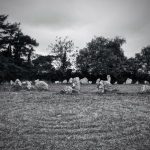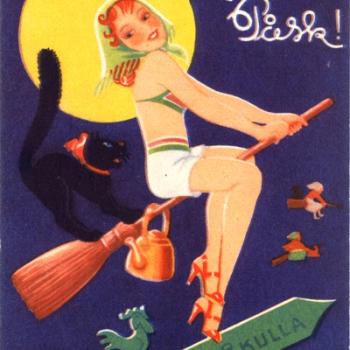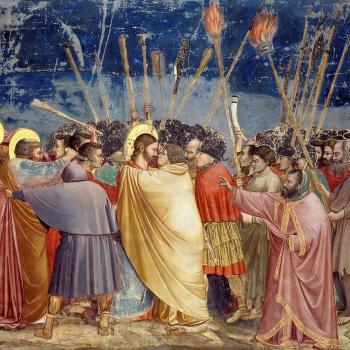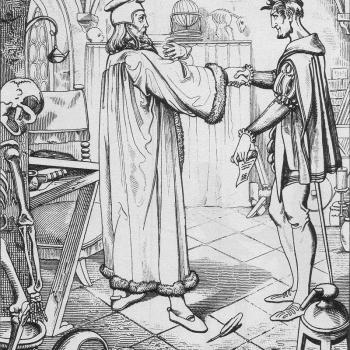
Traditional Witchcraft has become rather popular among the neopagan and occult milieu today, allowing freedom to explore through personal experience and learning. A decade or two ago, things were a little different and there were certain phrases and sayings you might hear in studying this area. One example is the Crooked Path, a reference coined by the late Andrew D. Chumbley in reference to a particular aspect pertaining to Sabbatic Witchcraft embodied in the outer through the conclave known as Cultus Sabbati.
Another concept that has since fallen out of fashion of late is that of Cain, the Witchfather and first sorcerer, and his commonly associated successor, Tubal-Cain. Perhaps one reason for this omission in recent times is the inference of a Judeo-Christian origin which continues to dissuade those new to witchcraft from exploring this rich vein further. The pedigree of our Christian world-view is long and persists in all parts of our collective perspective and daily lives, influencing even the most unexpected corners. For this and myriad other reasons, many come to witchcraft with an established aversion to Christianity and a desire to embrace that which is so anathema to the Church. There is a need to relinquish such cultural conditioning in order to progress, and inversion and reversion, commonly characteristic of Sabbatic Witchcraft, proves most useful in this endeavour. In his seminal work, Mastering Witchcraft: A Practical Guide for Witches, Warlocks and Covens (1970), Paul Huson provides the rubric and words for reciting the Lord’s Prayer backwards, an historical and simple initiation rite in the spirit of inversion. The performance of this can be seen to release the shackles of perceived religious dogmas and cultural conditioning in a profound and powerful way to some.
With the above in mind, it is pertinent to caveat the following with the understanding that the tradition of witchcraft which is referred to is not neopagan, but ‘dual-faith’. Nor is it averse to accessing the areas of the collective psyche in order to work effective operative witchcraft. In this, it is necessary to outline that the Christian worldview, being the predominant, in some cases only, perspective available to our medieval ancestors, it has helped shape our modern world in the most fundamental of ways. To not acknowledge this might be seen as tossing the baby out with the bathwater. Furthermore, it has long been the heritage of witchcraft to incorporate Biblical myth as part of its inherited body of tradition, as well as the use of Psalms and the physical Bible in spell-work. The witchcraft of which we speak here does not presume to be the final word upon any subject and, as ever, is open to interpretation from the perspective of the reader as they will. If this does not pertain to your witchcraft, then you are at liberty to discard whatever material you deem unfit or of no use to the function of your craft.

Huson commences Mastering Witchcraft with a myth of the origins of sorcery with the fallen angels, or Watchers, within the frame of Biblical literature. Drawing from witch lore and the narrative of Enochian fallen angels, the Introduction discusses the Luciferian origins of witchcraft, through the Watchers, angels charged with the care and education of early man, and who transgressed when they were intimate with women. The product of this angelic intercourse is, according to legend, the Nephilim, giants and ogres of many cultural legends, as well as the witchblood and subsequent witches.
This origin story of witches and witchcraft incorporates many elements which draw form ancient and modern mythologies and narratives. Importantly, Mastering Witchcraft is not a standalone incident of this legend which features not only in Witchcraft, but more pertinently the Craft – that is, Freemasonry.
Rudolph Steiner, an early 20th Century Rosicrucian and Masonic researcher, reveals the legend of Hiram Abiff and his vision of Tubal-Cain, who takes the protagonist to his grandfather, Cain. The first murderer there imparts the wisdom of how to combine successfully fire and water and gifts Hiram with the tools of the trade. This significant episode forms a part of the origin story of Freemasonry, suggesting a close proximity with Witch lore beyond the degree system introduced by Gerald Gardner when constructing Wicca.

Furthermore, the inclusion of Cain and Tubal-Cain as mythical and tutelary figures is not restricted to the Freemasons and Witch cult. Perhaps, as writers such as Mike Howard suggest in Pillars of Tubal Cain, the bridge between the two esoteric sodalities is the Society of the Horseman’s Word. This latter organisation has been subsumed, in some parts of the country, into regular Freemasonry and, indeed, would appear to hold within its ritual and myth both Cain, as founder, and Tubal-Cain as master smith and horseman.


















